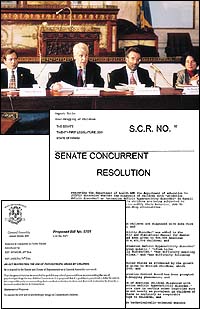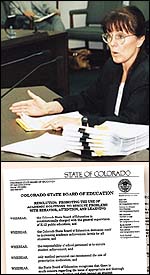
A Public Backlash
The trend of psychiatric labelling and drugging of children is recoiling across AmericaBy Marc Steven

| ||
 |
EVIDENCE MOUNTS ACROSS THE COUNTRY OF COERCION by school counselors, administrators and teachers to place children on drugs for disorders which have no scientific basis. (Top:) A panel of experts chaired by Bruce Wiseman, President, Citizens Commission on Human Rights United States, presents a report in Pennsylvania of findings on psychiatric abuse of children in schools. (Bottom:) Resolutions or laws have been passed in eight states, and introduced in eleven more, to curb the trend. |
 |

r. Fred Baughman first noticed the anomaly in the mid-1960s in his neurology practice in Grand Rapids, Michigan. Local schools began to refer children suspected of having brain and neurological disorders to him for stimulant drug prescriptions. Although such drugs are akin to speed, they tend to have the reverse effect of slowing individuals down when administered before puberty.
When Dr. Baughman conducted rigorous physical and neurological exams, he could find no trace of any physical disease or pathology in any of the children sent to him. He assured the parents their children had no disease or neurological disorder, and refused to prescribe stimulants.
Then the matter turned personal in 1969, when the school principal for Dr. Baughman’s second-grade son suggested the boy be given Ritalin, the stimulant drug then most commonly prescribed to children. His son refused, insisting, “I’m not mental. I’m not taking that stuff.”
Dr. Baughman and his wife also opposed the idea. Their son was “a handful,” but entirely normal. They used common-sense parenting and discipline, and today he is a successful executive.
Test Scores Plummet
Not all parents took the Baughmans’ course and, by 1970, school personnel across the country had seen to the placement of 200,000 children on substances for new claimed psychiatric conditions rapidly becoming buzz words of control within the educational system, such as Minimal Brain Dysfunction (MBD) and Hyperactive Child Syndrome (HCS). Today the number of schoolchildren on psychiatric drugs, including central nervous stimulants and anti-depressants, is approximately eight million.
Dr. Baughman moved to San Diego in 1975, and by 1993, he had examined hundreds of children referred to him by fellow physicians and schools for diagnosis and prescription for MBD, HCS and the more recent labels of Attention Deficit Disorder (ADD) and Attention Deficit Hyperactivity Disorder (ADHD). He also observed that educational test scores plummeted as the numbers of children labeled with such disorders escalated, the rolls of those attending “special education” classes swelled and the presence and influence of psychiatrists and psychologists increased in schools.
Dr. Baughman first attempted to open the eyes of his professional colleagues to the declining reading ability of children and to what he observed to be fraudulent diagnosing, labeling and drugging.

| ||
 |
“The victimization of children [by the psychiatric industry] leaving them illiterate and not educable, is criminal.” – Dr. Fred Baughman expert on fraudulent psychiatric diagnoses and drugging of children |  |
Conventional Wisdom vs. Facts
Dr. Baughman refused to yield to “conventional wisdom” and the pressure that could be exerted to keep a lucrative drug on the market, even when proven to be harmful.
He had seen it before.
In the early 1960s, as a researcher in Boston in one of the first chromosome laboratories in the country, and later as a consultant at the regional amputee center in Grand Rapids, Dr. Baughman observed infants born with deformities from thalidomide, a drug for morning sickness.
Because of reported ill effects in experimental animals, the U.S. Food and Drug Administration (FDA) acted early and prohibited thalidomide in the United States. But in the rest of the world, 10,000 women gave birth to children with congenital limb amputations and other problems before the drug was withdrawn. The British manufacturer, Distiller’s Co., attacked and vilified anyone trying to expose thalidomide as the cause of the wave of birth defects sweeping Europe, and continued to promote it for morning sickness in pregnant women.
For Dr. Baughman, the marketing of drugs for ADD/ADHD and other childhood disorders, and thalidomide in the early 1960s, share a common denominator: profits placed above health and safety concerns.
Although more doctors had joined the ranks opposing the use of psychotropic drugs on healthy children, the fraudulent representation of ADD/ADHD has been difficult to crack due to sharp and well-funded public relations and marketing campaigns which have convinced many other medical doctors across the country to put children, including one-year-old toddlers, on drugs that can radically alter and permanently damage the brain and central nervous system.
Yet, doctors like Baughman still could find no pathological or physical evidence proving the existence of these disorders, nor has the psychiatric industry found any. Although an estimated four to six million children today are prescribed central nervous stimulants for ADD and ADHD, the scientific community has yet to find or produce any evidence that they actually exist as medical conditions, i.e., that children said to have ADD or ADHD are anything other than normal.
No Medical Evidence

| ||
 |
TRAGIC TESTIMONY Parents testify to being threatened with expulsion of their children from school if they refuse to drug them. |
 |
A report of the National Institutes of Health’s Consensus Conference on ADHD, November 16-18, 1998, came to the same conclusion: “[W]e do not have an independent, valid test for ADHD, and there are no data to indicate that ADHD is due to brain malfunction.”
In an effort to refute this truth, some ADHD researchers have offered evidence that ADD/ADHD is a biologically based, chemical imbalance, consisting of observations that the brains of those so diagnosed had shrunk an average of 10 percent.
Other doctors point out, however, that the evidence omits that test patients had already been administered stimulant drugs, often over a prolonged period—brain damage from extended use of such drugs being a proven medical fact. The addiction potential of one central nervous stimulant commonly prescribed to children, methylphenidate (sold as Ritalin and in generic forms) has long since been reason enough for the U.S. Drug Enforcement Agency to classify it as a Schedule II controlled substance, along with opium, morphine, amphetamines and cocaine.1
While other proffered evidence has consisted of testimonials of some parents that children were finally manageable or “focused” once they took a drug, “It doesn’t make the drugs any less dangerous or addictive. And they do not solve education, moral and disciplinary failures,” Dr. Baughman said.
In fact, the NIH’s ADHD consensus conference report admitted that while stimulant drugs are most commonly prescribed for ADHD, they result in “little improvement in academic achievement or social skills.”
The practice of blaming learning and behavior matters on “mental disorders” accelerated in 1968 when the American Psychiatric Association published the second edition of the Diagnostic and Statistical Manual of Mental Disorders (DSM-II). In contained a new category of seven “Behavior Disorders of Childhood and Adolescence”.
Over the third and fourth editions of the DSM, a host of new mental disorders were added to the section, including: Attention Deficit Hyperactivity Disorder, Conduct Disorder, Developmental Reading Disorder, Developmental Language Disorder, Separation Anxiety Disorder, Overanxious Disorder, Mathematics Disorder, Oppositional Disorder and Learning Disorder Not Otherwise Specified.
The science behind the increase in the so-called disorders has a lot to do with the mathematics of profits. The NIH consensus conference report said, “additional national public school expenditures on behalf of students with ADHD may have exceeded $3 billion in 1995.”
Decision Overruled

| ||
 |
SPECIAL REPORT RESOLUTIONS PASSED In 1999, the Colorado State Board of Education, at the urging of then member Patti Johnson, passed a resolution calling for academic rather than drug solutions to classroom learning and behavioral problems. The resolution sparked a national trend of similar measures to end psychiatric drugging of children as a fraudulent and harmful practice. |
 |
The case is still the prevailing law in this country, but the victory has often been overruled in practice by teachers, principals and even family court judges who sometimes compel parents to permit drugging of their children, using the threat of a negligence charge or loss of custody.
Such was the experience of Redd Howe of Chattanooga, Tennessee, who disagreed with his son being forced onto Ritalin by local school officials. He found documents in his son’s school file in October 1997 that stated the boy was not in fact diagnosed with ADHD or ADD.
“When I told the school officials to stop giving my son Ritalin, they refused to let me speak,” he said. Howe learned of Dr. Baughman and contacted him, obtaining information that he says “changed his life.” Howe accused the school board in May 1998 of fraud, educational malpractice, violation of informed consent rights, practicing medicine without a license, and assault and battery.
“My apartment was broken into and files stolen,” he said. “I was put under a gag order and forbidden to speak at school board meetings. I was charged with aggravated criminal trespass for being on school grounds.”
With the help of publicity from a local newspaper investigating Howe’s case, the school board is now finally considering adopting policy that prohibits teachers from suggesting medical diagnosis or medication. “This is a victory for all families,” said Howe.
A growing number of parents are fighting back against the enforced drugging of their children across the country.
A Return to Education
At the other end of the educational spectrum, Patti Johnson, when an elected member of the Colorado State Board of Education in the mid and late 1990s, found herself receiving complaints from parents pressured by teachers and counselors to either drug their children or remove them from school.
For two years, she tried to change the rules, but it was not until the shooting deaths of 12 students and a teacher at Columbine High School in Littleton, Colorado, in April 1999 that the board listened. Eric Harris was one of a long line of young killers around the country found to be taking psychiatric drugs.
Johnson drew up a resolution for the State Board of Education and brought in several experts, including Dr. Baughman, who, she recalls, “exposed the lie the board had been fed by psychiatrists. The members finally saw that children experiencing difficulty studying was the result of a deteriorating educational system, not a neuro-biological or chemical imbalance for which drugs were the solution.”
The board passed the resolution in July 1999 six to one, stating that as educators, their field is academics and classroom discipline, not the promotion of drug use.
Since then, resolutions and laws have been passed in states throughout the country with Connecticut, in a unanimous legislative vote in July 2001, the first state to make it illegal for any school teachers or counselors to recommend psychiatric drugs for any child.
Meanwhile, a growing list of professionals like Dr. Baughman and Patti Johnson are working with organizations such as the Citizens Commission on Human Rights2, which has chapters worldwide, and parents throughout the country who are finding they have a strong, international network of support for protecting their children.
Ultimately, Dr. Baughman believes, the psychiatric community must answer for the destruction of a significant portion of America’s future. “The victimization of children,” he said, “leaving them illiterate and not educable, is criminal.”
1 Methylphenidate, A Background Paper, Drug and Chemical Evaluation Section, Office of Diversion Control, Drug Enforcement Administration, October 1995
2 The Citizens Commission on Human Rights (CCHR) is an international watchdog group established by the Church of Scientology in 1969 to investigate, expose and bring to justice psychiatric violations of human rights.

